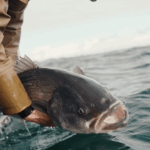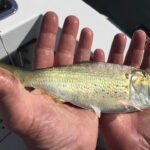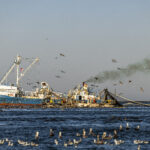
Release Mortality Revisited: New Research from Massachusetts DMF
Feature Photo Credit: Robbie Tartaglia What’s going on? For decades, striped bass management relied on a
Addendum II for Striped Bass Fails to Move Forward for Public Comment at Summer ASMFC Meeting. “Fiddling while Rome burns” has become an art form for this management body.
Feature Photo: Dan Zazworsky aboard with Capt. Zak Robinson.
On Tuesday, August 1st, 2023, the ASMFC Striped Bass Management Board delayed releasing Addendum II for public comment. This action will delay the implementation timeline substantially and at a critical time in the process of rebuilding this fishery. Final action has been bumped to the ASMFC meeting in January of 2024, creating a chain reaction of events that doesn’t bode well for the rebuilding timeline of Atlantic striped bass.
The bottom line is that changes can only be made to the commercial fishery at the end of this process. The 2024 commercial quotas will be set by the time we can accomplish the final action, meaning those quotes remain unchanged for another season.
In this blog, we will stay at a higher level, aiming to summarize items removed and added to the draft document, excluding discussions about catch and release mortality. There will be a stand-alone piece in the near future focused solely on catch and release.
The burden of “sacrifice for the greater good” continues to be placed on the recreational community. The Emergency Action achieved a 14% reduction in the ocean recreational fishery and only a 2% reduction in the Chesapeake. The Chesapeake commercial fishery, with a quota larger than the entire ocean combined, has yet to take a reduction to its 3-million-pound quota. It’s hard to feel that all parties and sectors are equally committed to the conservation of this fishery – mainly because they are not.
A few Commissioners are working with an evident passion for rebuilding the stock their territory’s constituents rely on. Meanwhile, other commissioners seem only concerned about special interests in their respective states. These parties seem immune to the signs that striped bass numbers will fall off a cliff in 2027.
The goal of the August 1st meeting was to audit the draft addendum document. By removing options and editing others, the Board aims to make an easily-palatable document for the public to digest and comment on. Thanks to Mike Armstrong and Cherie Patterson, this goal was accomplished to a certain degree.
You can review the wide range of options included in the draft Addendum II by downloading this PDF. Please note that while in draft status, none of the changes to this document are considered final. Who knows what will happen at the October meeting? Another spawn failure in 2023 may move the Board to act. Some commissioners may bring a removed topic back to the table. We can’t make those predictions, so consider this an update on what happened recently with no promises for the next meeting.
Chesapeake Bay
On Page 16 in the document linked above, you can see that the draft includes options A through I. The motion below trimmed that down to options B, D, and H.

The Ocean
On Page 14, you can see the draft with all the following options listed. The motion below removed all seasonal closures and options C and D.

Commercial, Ocean & Bay
This is where things went off the rails. There needs to be more analysis on spawning potential to institute maximum sizes for the commercial fishery. The other option is a simple 14.5% reduction without max sizes. Both options leave a little to be desired. The 14.5% reduction for commercial would be taken off the quota not landings. In many cases, this would mean a net zero reduction in harvest. As certain states did not hit their quota in the past, those states would simply be taking a trim of fish their not even catching. The total reduction would be a net zero.

One addition that we hoped wouldn’t come up is a mode split with the charter-for-hire fleet. This may seem like a weird place for us to put our foot in the sand since we are the American Saltwater Guides Association. We’d like to be clear on our position:
Striped bass are in deep trouble. Every stakeholder group should be contributing equally to rebuilding striped bass stocks. We oppose carve-outs for any group in this specific situation. Now that we’ve established that baseline, here is the motion:

Mode splits (carve-outs) will be included for comment once the document is finalized. We should have learned from the past. Maryland allowed for charter mode splits and that fleet killed more fish than the entire ocean fleet and the rest of the bay fleet combined. This is a bad idea considering the context and condition of striped bass.
We will follow up this blog with another article getting into the weeds on catch and release and non-targeting closures. For now, all we can do is continue to grow our army of advocates, further our collective education on the state of this fishery and strengthen our voices as this Addendum II process continues. In the meantime, get out on the water at try to catch a couple of fish, take good care of the fish you release and reinvigorate your love for these striped fish.


Feature Photo Credit: Robbie Tartaglia What’s going on? For decades, striped bass management relied on a

Recent developments in the 2025 Atlantic Menhaden Stock Assessment Update, released by the Atlantic States

What’s going on? The “most important fish in the sea” just exposed one of the

Mario CampoFisheries Ecologist, Southeastern Louisiana UniversityScience and Policy Associate, American Saltwater Guides Association This discussion
We rely on our members and donations to keep fighting for a sustainable tomorrow in marine conservation.
GIVE THE GIFT OF FISHERIES CONSERVATION THIS HOLIDAY SEASON. SHOP ASGA GOODS THAT FUND FISHERIES RESEARCH & ADVOCACY CAMPAIGNS
JOIN ASGA IN CALLING FOR CRITICAL MANAGEMENT ACTION AFTER YEARS OF SPAWN FAILURES & POOR MANAGEMENT.
By using this website, you agree to our use of cookies. We use cookies to provide you with a great experience and to help our website run effectively. To learn more, please review our privacy policy.
5 Responses
Thank you for working so hard and letting those that fish for striped bass understand how they are being managed. I couldn’t guess how much revenue is generated by a healthy bass population, that includes recreational fishermen and commercial fishermen. And I haven’t thought of boat sales, marinas, gas, and even food sales. I would guess I’m not alone when I spend $25-$35 at my local sandwich shop just for a lunch to take aboard. A protected striper fishery regulated properly is vital to so many people and businesses. There is no time to waste.
Chuck,
It is in the billions every year (coastwide)
Just listened to the podcast… I want to cry. I want to reprimand the mid-atlantic commissioners… I have more respect for striped bass than I do most people. So $%&^$# depressing…
Hey Greg… This is why we fight. You win some and you lose some. In the end, we will win. Bet on it.
The future is in jeopardy as we have not seen a single bunker (meheden) along our south jersey coast this season. Where did they go who caught them. What is left for the bass to eat.